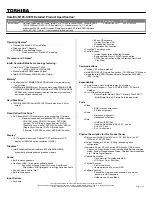
User’s Manual
Glossary-3
Glossary
analog signal:
A signal whose characteristics such as amplitude and
frequency vary in proportion to (are an analog of) the value to be
transmitted. Voice communications are analog signals.
ANSI:
American National Standards Institute. An organization established
to adopt and define standards for a variety of technical disciplines.
For example, ANSI defined the ASCII standard and other
information processing requirements.
antistatic:
A material used to prevent the buildup of static electricity.
application:
A group of programs that together are used for a specific task
such as accounting, financial planning, spreadsheets, word
processing and games.
ASCII:
American Standard Code for Information Interchange. ASCII code
is a set of 256 binary codes that represent the most commonly used
letters, numbers, and symbols.
async:
Short for asynchronous.
asynchronous:
Lacking regular time relationship. As applied to computer
communications, asynchronous refers to the method of transmitting
data that does not require a steady stream of bits to be transmitted
at regular time intervals.
B
backup:
A duplicate copy of files kept as a spare in case the original is
destroyed.
batch file:
A file that can be executed from the system prompt containing
a sequence of operating system commands or executable files.
binary:
The base two number system composed of zeros and ones (off or
on), used by most digital computers. The right-most digit of a binary
number has a value of 1, the next a value of 2, then 4, 8, 16, and so
on. For example, the binary number 101 has a value of 5.
See also
ASCII.
BIOS:
Basic Input Output System. The firmware that controls data flow
within the computer.
See also
firmware.
bit:
Derived from "binary digit," the basic unit of information used by the
computer. It is either zero or one. Eight bits is one byte.
See also
byte.
board:
A circuit board. An internal card containing electronic components,
called chips, which perform a specific function or increase the
capabilities of the system.
boot:
Short for bootstrap. A program that starts or restarts the computer.
The program reads instructions from a storage device into the
computer’s memory.
bps:
Bits per second. Typically used to describe the data transmission
speed of a modem.
buffer:
The portion of the computer’s memory where data is temporarily
stored. Buffers often compensate for differences in the rate of flow
from one device to another.
Содержание PQG30
Страница 1: ...Qosmio G30 TOSHIBA Qosmio G30 Portable Personal Computer User s Manual ...
Страница 26: ...xxvi User s Manual Table of Contents ...
Страница 30: ...xxx User s Manual Preface ...
Страница 34: ...xxxiv User s Manual General Precautions ...
Страница 82: ...3 16 User s Manual Getting Started ...
Страница 118: ...4 36 User s Manual Operating Basics ...
Страница 188: ...8 36 User s Manual Using the Remote Controller Front operation button and QosmioPlayer ...
Страница 244: ...A 4 User s Manual Specifications ...
Страница 264: ...C 10 User s Manual AT Commands ...
Страница 272: ...D 8 User s Manual S registers ...
Страница 276: ...E 4 User s Manual V 90 ...
Страница 286: ...G 6 User s Manual TOSHIBA RAID ...
Страница 294: ...H 8 User s Manual Bluetooth wireless technology Interoperability ...
Страница 298: ...J 2 User s Manual Usage Restrictions ...
Страница 317: ...User s Manual Index 5 Index X xD picture card 9 9 inserting 9 9 removing 9 9 ...
Страница 318: ...Index 6 User s Manual Index ...
















































